Creating and Measuring Surgical Conscience
May 17, 2023
By Chris Becker
The prospect of surgery, even minor surgery, can be frightening for a patient. Nobody wants to get even sicker after an operation. But despite the number of responsible, caring teams who perform challenging surgery and perioperative care with great skill, studies point to significant numbers of patient sicknesses and deaths caused by incorrect and often preventable actions on the part of surgeons and preoperative nurses. Contributing to those numbers is a culture where perioperative nurses are discouraged from or ignored when advocating for perioperative safety protocols.
“If you want to know why a patient has a surgical site infection, look no further than the time a nurse couldn’t vocalize that something got contaminated,” said Danielle Quintana, clinical assistant professor at the Gessner College of Nursing. “Until these numbers are zero, there’s more work to do.”

In December 2022, Quintana’s article “Surgical Conscience: A Concept Analysis for Perioperative Nurses” appeared in AORN, the official journal of the Association of periOperative Registered Nurses. In it, she advocates professional standards and principles of aseptic technique, sterility and infection control, as it empowers those in the surgical environment to stop a procedure if there are discrepancies, regardless of the consequences.
“In the operating room, we think of surgical conscience as our golden rule,” said Quintana, whose OR career spans three decades. “But in the OR, it’s bumped up by the fact that the patient can’t speak for themselves, and there is no family there to protect them. So the OR nurse becomes the patient’s ‘voice.’”
Quintana is also introducing her students to surgical conscience, since UH is one of the few universities in the nation to offer undergrads a two-credit class in perioperative nursing.
“We’ve had a strong perioperative nursing class for at least a decade,” says Quintana. “So, we have the perfect place to teach surgical conscience.”
Growing up in New Jersey, Quintana began volunteering as a candy striper in a hospital at age 16; one of her tasks was to bring needles and syringes to the OR.
“I loved it,” said Quintana of her first experience in the operating room. “Just seeing how the (OR) team works together without even talking to one another . . . that really hit the spark for me.”
She went on to become a surgical technologist, a role she held while going to nursing school. But as Quintana prepared for the next steps of getting her doctorate, she realized there was very little published research on surgical conscience. Although the term is not new — it first appeared in the Journal of Surgery in 1930 — its meaning and practical applications had remained more anecdotal than quantifiable.
Quintana decided to change this by creating an easy-to-articulate model for surgical conscience. While there certainly are guidelines from the Association of Operating Room Nurses and the World Health Organization designed to keep patients safe in the OR, much more needs to be done.
“The protocols are only as good as the people who decide to use them, or not,” said Quintana. “And that’s surgical conscience.”
Sadly, there can be repercussions for doing the right thing. Nurses may be wary of speaking up about a safety concern, even if doing so is in the best interest of the patient.
“The culture of the department has a lot do to with that,” said Quintana. “It gets really political sometimes, and people do get defensive.”
After publishing her concept analysis, Quintana used her dissertation to develop two new tools, one for measuring the barriers that can prevent a nurse from speaking up for the patient, and the second for a person’s overall level of surgical conscience. Next year, Quintana has plans to share these tools with hospitals to strengthen and later re-measure the surgical conscience level of perioperative nurses.
The Gessner College of Nursing is housed at the Sugar Land instructional site.